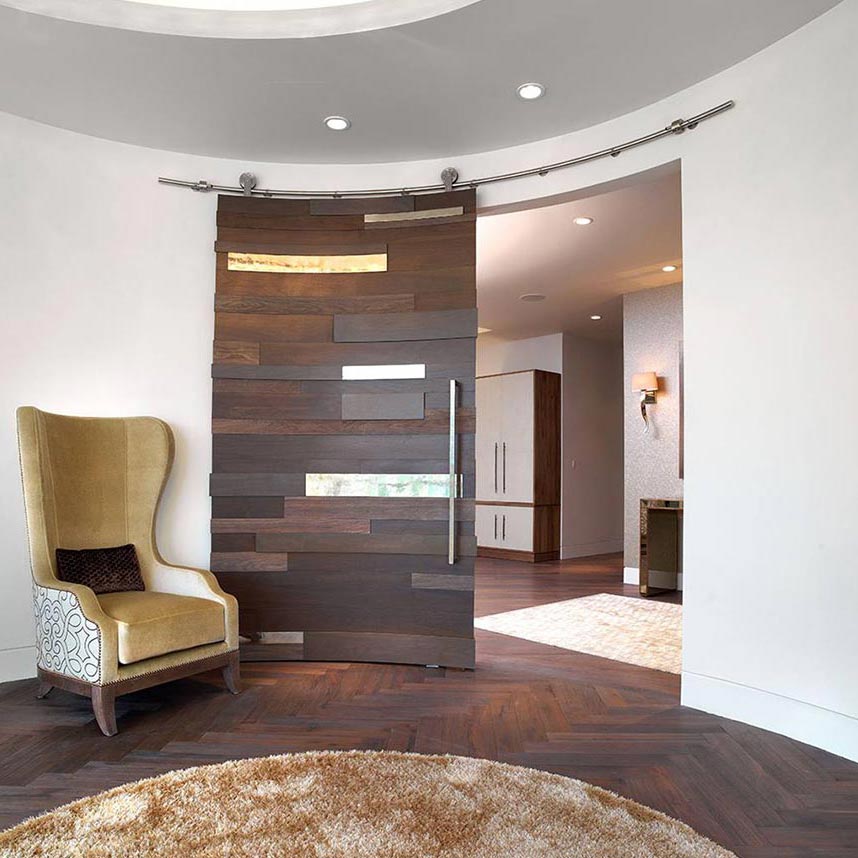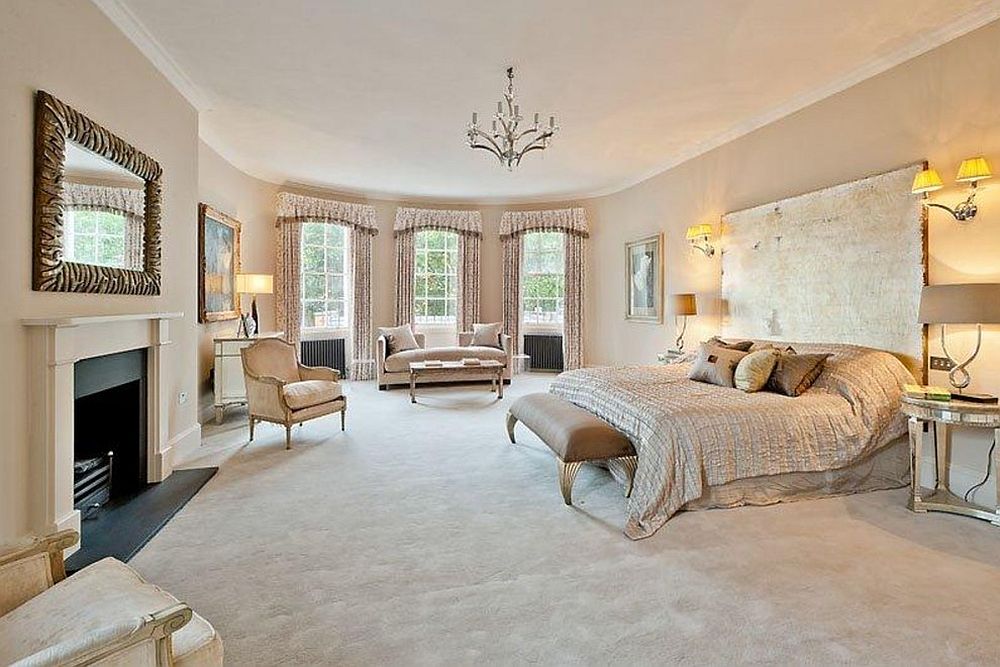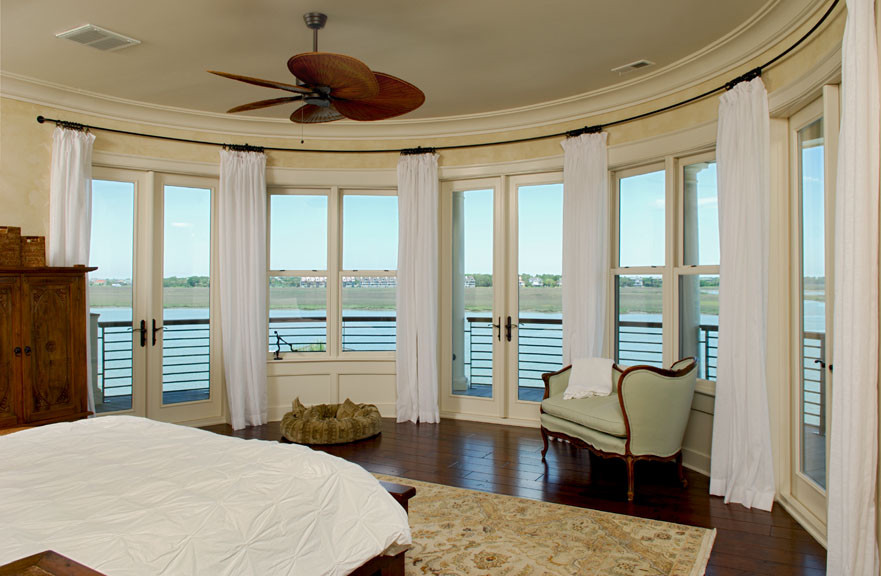Design Considerations for a Bedroom with a Curved Wall

Curved walls add a unique and captivating element to a bedroom, transforming the space from ordinary to extraordinary. This architectural feature can create a sense of fluidity, movement, and visual interest, offering a departure from traditional rectilinear designs.
Types of Curves
The type of curve you choose will significantly influence the overall feel of your bedroom. A gentle, sweeping curve can create a sense of calm and tranquility, while a more pronounced curve can add drama and dynamism. Here are some common types of curves used in bedroom design:
- Concave Curves: These curves bulge inwards, creating a sense of intimacy and enclosure. They are ideal for creating cozy reading nooks or seating areas within the bedroom.
- Convex Curves: These curves bulge outwards, creating a sense of expansiveness and openness. They can be used to create a focal point in the bedroom, such as a headboard wall or a dressing area.
- S-Curves: These curves are characterized by a gentle, flowing shape that resembles the letter “S.” They can add a touch of elegance and sophistication to a bedroom.
Integrating Furniture and Decor
Curved walls present a unique challenge for furniture placement, but they also offer a plethora of creative opportunities. Here are some tips for integrating furniture and decor to complement a curved wall:
- Embrace the Curve: Instead of trying to force rectangular furniture against the curve, consider using furniture with rounded edges or custom-designed pieces that follow the contours of the wall.
- Use Mirrors: Mirrors can reflect light and create the illusion of more space. Place a large mirror on a curved wall to visually expand the room and enhance the sense of flow.
- Play with Lighting: Lighting can accentuate the curves of the wall and create a warm and inviting ambiance. Consider using recessed lighting, sconces, or pendant lights that highlight the contours of the wall.
Bedroom Layout with a Curved Wall, Bedroom with curved wall
Imagine a bedroom with a curved wall separating the sleeping area from a dressing area. The curved wall is painted a soft, calming blue, while the rest of the room is painted a crisp white. The bed is placed against the curved wall, with a headboard that follows the curve of the wall. A bedside table with a rounded edge sits on either side of the bed. A large, arched mirror is placed on the curved wall, reflecting light and creating a sense of spaciousness. The dressing area features a vanity with a curved countertop that complements the wall. A comfortable armchair is positioned in the corner of the room, providing a cozy spot for reading or relaxing.
Maximizing Space and Flow
- Use Multifunctional Furniture: Choose furniture that serves multiple purposes, such as a bed with built-in storage or a vanity that doubles as a desk.
- Embrace Open Space: Avoid overcrowding the space with too much furniture. Leave ample space between furniture pieces to create a sense of flow.
- Use Light Colors: Light colors reflect light and create the illusion of more space. Paint the walls and ceiling in light colors to maximize the feeling of spaciousness.
Interior Design Inspiration for a Curved Wall Bedroom

A curved wall in a bedroom can add a unique and sophisticated touch to the space. It presents an opportunity to create a visually striking focal point and experiment with different design elements.
Design Styles for a Curved Wall Bedroom
The curved wall offers a canvas for various design styles. Here are a few examples:
- Modern Minimalist: This style emphasizes clean lines, simple shapes, and a neutral color palette. A curved wall can be used to create a focal point with a sleek headboard or a minimalist artwork.
- Mid-Century Modern: This style features organic shapes, warm wood tones, and a touch of retro charm. A curved wall can be incorporated with a rounded sofa or a vintage rug.
- Bohemian: This style embraces eclecticism, layering textures, and vibrant colors. A curved wall can be adorned with tapestries, macrame, or a collection of vintage mirrors.
- Art Deco: This style is characterized by geometric patterns, bold colors, and luxurious materials. A curved wall can be highlighted with a statement chandelier or a patterned wallpaper.
- Contemporary: This style prioritizes functionality, simplicity, and a modern aesthetic. A curved wall can be incorporated with a sleek bed frame, a minimalist desk, or a contemporary artwork.
Color Palettes and Materials
The color palette and materials used in a curved wall bedroom can greatly impact the overall mood and feel of the space.
- Color Palettes:
- Neutral Palettes: White, gray, beige, and black create a sense of calm and serenity.
- Warm Palettes: Earthy tones like brown, orange, and yellow promote a cozy and inviting atmosphere.
- Cool Palettes: Blue, green, and purple create a refreshing and relaxing vibe.
- Materials:
- Wood: Adds warmth, natural beauty, and a touch of rustic charm.
- Metal: Creates a modern and industrial feel.
- Stone: Provides a timeless and elegant touch.
- Fabric: Adds texture, comfort, and visual interest.
Lighting to Enhance the Curved Wall
Lighting plays a crucial role in highlighting the unique shape of a curved wall and creating a desired ambiance.
- Recessed Lighting: Provides even illumination and minimizes shadows.
- Sconces: Create a warm and inviting glow, particularly when placed along the curved wall.
- Pendant Lights: Offer a dramatic focal point, especially when positioned above a bed or a seating area.
- String Lights: Add a whimsical and cozy touch, especially when draped around the curved wall.
Furniture for a Curved Wall Bedroom
Furniture selection should complement the curved wall and create a balanced and functional space.
- Beds:
- Round Beds: Embrace the curve of the wall and create a unique focal point.
- Platform Beds: Offer a clean and minimalist aesthetic, ideal for a modern or contemporary style.
- Canopy Beds: Add a touch of romance and grandeur.
- Other Furniture:
- Rounded Chairs or Ottomans: Complement the curve of the wall and provide comfortable seating.
- Curved Desks or Vanity Tables: Add a unique touch and provide a functional workspace.
- Modular Furniture: Allows for flexibility and adaptability, especially in smaller spaces.
Creating a Focal Point
A curved wall naturally becomes a focal point in a bedroom. Here are ways to further enhance it:
- Artwork or Mirrors: Hang a large artwork or a collection of mirrors on the curved wall to draw attention.
- Wallcovering: Use a patterned wallpaper or a bold paint color to highlight the curve and add visual interest.
- Lighting: Use strategically placed lighting to create a dramatic effect and emphasize the shape of the wall.
- Accent Furniture: Place a statement chair or a decorative console table against the curved wall to create a visual focal point.
Practical Aspects of Building a Curved Wall: Bedroom With Curved Wall

A curved wall in a bedroom can be a beautiful and unique design element, but it also presents some practical challenges. This section explores the various construction methods, step-by-step guides, structural integrity considerations, challenges and solutions for incorporating curved walls into existing bedrooms, and design ideas for integrating storage solutions.
Construction Methods for Curved Walls
The method of construction for a curved wall depends on factors like the size and complexity of the curve, budget, and desired finish.
- Drywall: This is the most common method for creating curved walls. It involves bending drywall sheets over a curved frame made of wood or metal studs. This method is cost-effective and versatile, allowing for various curve radii.
- Plaster: Plastering over a curved frame is a traditional method that creates a smooth, seamless finish. This method requires skilled labor and is typically more expensive than drywall.
- Curved Panels: Pre-fabricated curved panels made of materials like plywood or MDF are available and can be easily installed. These panels come in various shapes and sizes, making them ideal for smaller curves or for creating specific designs.
- Brickwork: Creating a curved brick wall is a labor-intensive process but offers a unique aesthetic and durability. This method is typically used for larger curves and requires specialized skills.
Designing and Building a Curved Wall
Creating a curved wall involves a detailed planning process.
- Planning and Design: Determine the desired shape and size of the curve, considering the room layout and furniture placement. Sketch the design and use software tools like AutoCAD or SketchUp for detailed visualization.
- Framing: Construct a curved frame using wood or metal studs. The frame should be strong enough to support the weight of the wall finish. For larger curves, use multiple layers of studs for added support.
- Sheathing: Attach sheathing material, like plywood or OSB, to the frame. This creates a smooth surface for the final wall finish.
- Finishing: Apply the chosen wall finish, such as drywall, plaster, or curved panels. Ensure the finish is properly secured and smooth.
Ensuring Structural Integrity
A curved wall requires careful consideration of structural integrity to ensure stability and prevent potential issues.
- Proper Framing: Use strong and properly spaced studs to support the wall finish. Consult a structural engineer for larger or complex curves.
- Load Distribution: Ensure the load of the wall is evenly distributed on the framing. Use proper bracing and support systems.
- Reinforcement: Consider using additional reinforcement, like steel angles or plates, for areas of high stress or where the wall is subjected to heavy loads.
Challenges and Solutions for Curved Walls in Existing Bedrooms
Incorporating a curved wall into an existing bedroom presents unique challenges.
- Existing Structure: Existing walls, doors, or windows may need to be adjusted or relocated to accommodate the curve. This may require significant structural modifications and professional expertise.
- Furniture Placement: Curved walls can create challenges with furniture placement and movement. Consider the placement of beds, dressers, and other furniture to ensure comfortable and functional use of the space.
- Lighting: The curved wall may affect the way light reflects and illuminates the room. Consider using strategically placed lighting fixtures to create a balanced and inviting ambiance.
Curved Walls with Integrated Storage Solutions
Curved walls offer unique opportunities for incorporating creative storage solutions.
- Built-in Shelving: Curved shelves can seamlessly blend into the wall, maximizing storage space while adding a visually appealing element.
- Hidden Storage: Incorporate hidden compartments within the curved wall, such as drawers or pull-out shelves, for discreet storage of personal items.
- Curved Closet: Design a curved closet to maximize space and create a unique focal point in the bedroom.